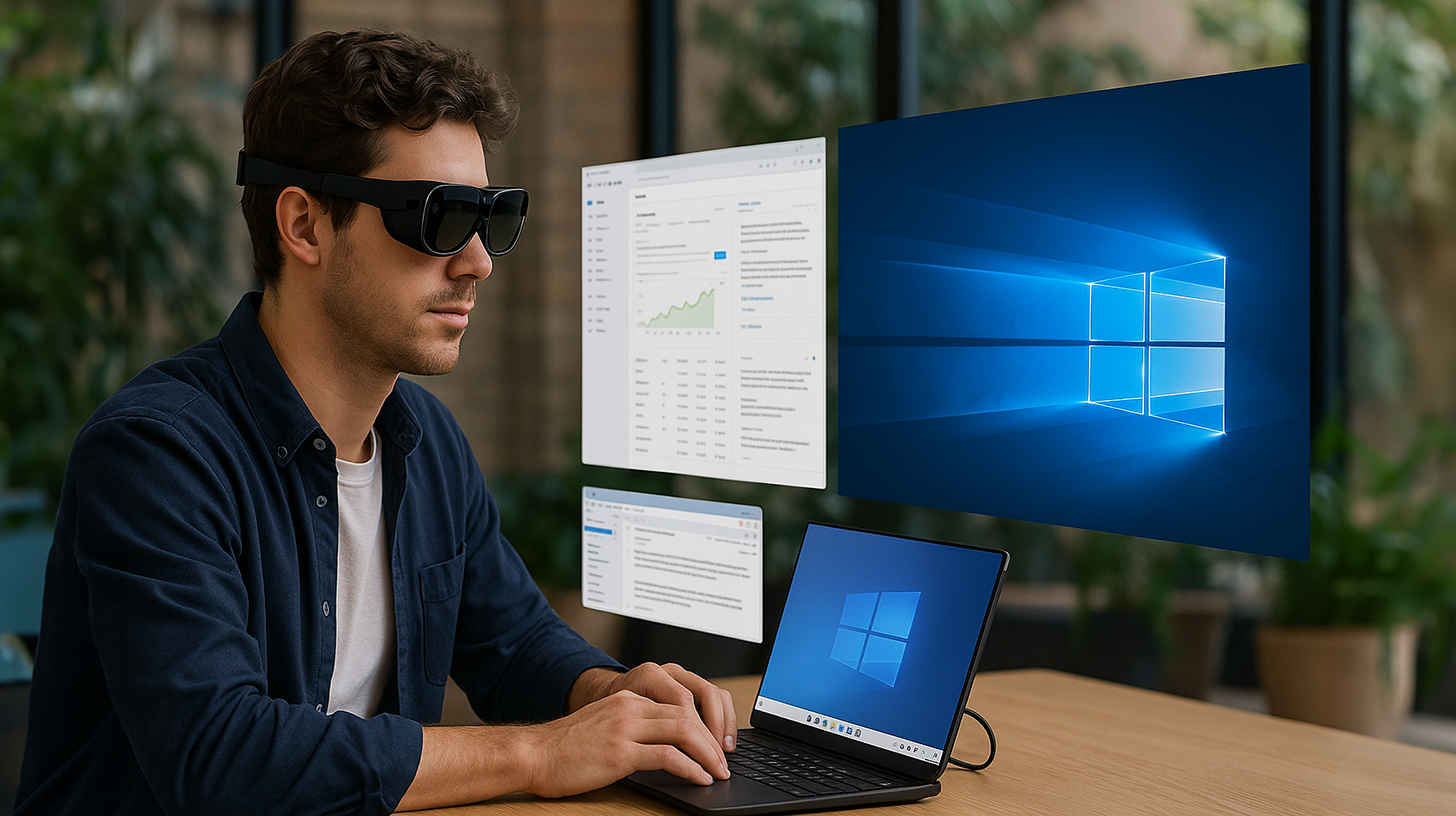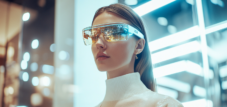
AR office: Augmented reality in the office and at work-work and conferences with AR glasses-Image: Xpert.digital
The AR office of the future: vision or soon reality?
AR office: The transformation of the workplace through augmented reality
The integration of augmented reality (AR) in office environments and in workplaces marks an important turning point in the development of modern forms of work. This technology expands the real world with digital elements and offers a variety of ways to optimize work processes, communication and cooperation.
Suitable for:
- Market opportunities for the AR workstation: Sightful Spacetop for Windows offers a 100-inch display work space for laptops with AR glasses.
Basics of augmented reality technology
Definition and delimitation to Virtual Reality
Augmented reality, translated into German as a “expanded reality”, describes a technology in which the perception of the real world is supplemented and enriched by additional digital information. In contrast to the virtual reality (VR), in which the user is in a completely virtual world and the reality is completely hidden, the physical environment remains visible in AR and is only expanded by virtual elements. AR makes this property particularly valuable for use in office environments, where interaction with the real environment and colleagues remains important.
Functioning of AR glasses
AR glasses capture the surrounding environment through cameras and other sensors. Information is then shown in the field of users via a display inside the glasses. Advanced AR applications scan the environment in real time and place digital 3D objects in perspective and scale in it. The AR systems are usually controlled via gestures and language, whereby the developers have to make sure that they are ergonomically designed and adapted to the respective work environment.
Area of application of AR in the office context
Mobile and flexible work
One of the most outstanding properties of AR glasses is their ability to create an individual work area at any location. Users can span several virtual monitors at the same time that integrate seamlessly into the existing environment. This enables a truly mobile office that is not bound to physical screens. This offers enormous flexibility in particular for professionals who are frequently on the go or work in the home office. The small glasses replace space -proof conventional screens and thus creates new opportunities for mobile work.
Ar in virtual meetings and conferences
Virtual meetings are now an integral part of modern office life. AR and VR have the potential to fundamentally change the way we hold meetings. These technologies offer the following advantages:
- Increased feeling of presence: With immersive environments, participants can interact with realistic avatars of their colleagues, which creates an authentic meeting experience.
- Minimization of distractions: AR can help reduce distractions by transferring participants to a focused virtual space.
- Individually designable meeting environments: Companies can design virtual meeting rooms according to their brand and needs.
Mixed reality in the office is no longer a distant vision of the future, but a driver of innovation in the area of New Work, which is already moving into modern offices.
Visualization and planning
AR offers innovative opportunities for visualization and planning in the office environment. For example, furniture can be placed virtually in the room in the office facility before they are actually bought. Möbel can be authentically integrated into the room view via the camera of a smartphone or tablet, which can make furnishing options simulate realistically. This gives customers the greatest possible security for their purchase decisions and optimizes the planning process.
Remote support and cooperation
AR enables effective forms of remote support and cooperation. Remote support tools allow experts to display visual instructions in the live video stream of a tablet, PCs or AR glasses in order to guide colleagues on site step by step. The experts see the same thing as the local employees, which makes communication considerably easier.
Complex 3D models can also be processed together by team members, even if they are physically in different locations. The same virtual model is displayed in a 3D room for everyone involved, and the colleagues appear as avatars. This form of cooperation goes far beyond simple video conferences and creates new opportunities for creative and technical teams.
Current AR glasses technologies and developments
Innovative display technologies
The Swiss company CREAL has developed a new prototype of its AR light field display, which is compatible with conventional correction glasses. This technology projects digital content with correct depth into the room so that each eye can focus on any distance, similar to the real world. This addresses a frequent problem of conventional AR and VR displays: the Vergenz-Akkommodation conflict, which can lead to headache and eye pain if used for a long time.
Current products on the market
Various manufacturers have already launched or announced AR glasses:
- Lenovo Thinkreaality A3: These glasses enable several virtual monitors to tense up at the same time and integrate them into the environment.
- Google presented new data glasses at the TED conference in Vancouver, which can hardly be distinguished from normal glasses. She works with the in-house AI assistant Gemini and can perform various tasks, including real-time translations and scanning books. The functionality of the Google glasses is based on a direct connection to the smartphone, which means that the hardware of the glasses itself can be kept very easily. All smartphone apps are available.
More about it here:
Advantages of AR in the workplace
Efficiency increase and productivity improvement
AR at work offers details, clarity, context and yardstick that are missing paper-based manuals and 2D instructions. This leads to a significant increase in efficiency in complex tasks. AR particularly plays its advantages for complex technical tasks, since the tedious translation of 2D instructions to 3D objects is no longer necessary and confusion of components or language barriers are minimized.
Ability of the employees
Augmented Reality enables employees by providing them with tools and information directly in the work context. The key to more efficient training, maintenance and inspection is qualified employees. AR technologies can be used to close gaps in the workforce, to accelerate the training and to give expanded skills to the field staff.
Support of remote work and hybrid work models
Flexible working models are becoming increasingly important in today's working world. According to studies, 77 percent of specialists want flexible work environments and a hybrid mix of home office and office hours. AR technologies can support this development by enabling effective collaboration over the distance and letting the boundaries between physical and virtual workplace blur.
Gesture-controlled efficiency: ergonomics as a key to AR glasses
Ergonomic aspects
Despite the many advantages of AR glasses, there are also challenges in the field of ergonomics. The physical stress by wearing AR glasses was examined in various studies. Although modern AR glasses are lighter and have an improved weight distribution, it is important to take into account when designing the workplace that users have an additional weight on the head.
The control via gestures should be carried out and ergonomically designed in accordance with the respective activity. Loudmaking must also be adapted to the environment.
Restrictions on the field of vision and perception
Another challenge is that AR glasses can limit the field of vision. In addition, there is a risk that too many overlays lead to the area no longer perceived by the sponsors. This can be particularly problematic in situations in which a complete perception of the environment is necessary for security reasons.
Data protection concerns and participation
The use of AR glasses at the workplace also raises data protection questions. It should be noted that the introduction of AR glasses is subject to co-determination. Depending on the type and scope of the use, various data protection aspects can be relevant, especially if the glasses are equipped with video functions.
Before the introduction of AR technologies, companies should carry out a data protection impact assessment and integrate the works council at an early stage.
Suitable for:
Future prospects for AR in the office
Integration with AI and other technologies
The future of AR in the office lies in integration with artificial intelligence and other advanced technologies. The AR glasses presented by Google, which works with the AI assistant Gemini, is an example of this development. The combination of AR with AI, cloud computing and 5G creates new possibilities for intelligent assistance systems, context-related information provision and extended collaboration functions.
Spatial computing as a new paradigm
The term “spatial computing” (spatial computing) describes a trend in which digital information is integrated directly into the physical space. This development could change the way we interact with computers, fundamentally change and enable new forms of human-computer interaction.
Change in office design
The increasing spread of AR technologies will also have an impact on the physical design of office space. This new technology needs certain structural requirements in order to be able to be used optimally. Companies should take these requirements into account when planning new office space or in renovations in order to create future -proof work environments.
Working world 4.0 - Virtual content, real advantages: augmented reality at work
Augmented reality in the office and at work is a promising technology that has the potential to fundamentally change our way of working. The ability to seamlessly integrate virtual content into the real world opens up new opportunities for cooperation, visualization and mobile work.
While numerous applications and products already exist today, the development of AR in the office account is still at the beginning. The continuous improvement of the hardware, in particular in terms of weight, comfort and visibility, as well as the development of more intuitive user interfaces will further promote the acceptance and spread of this technology.
Companies that invest in AR technologies at an early stage and gain experience can gain a competitive advantage and better position their employees for the working world of the future. At the same time, you should not underestimate the challenges in the field of ergonomics, data protection and employee training and pursue a holistic approach when introducing AR at the workplace.
The AR office is no longer a distant vision of the future, but a rapidly developing reality that will increasingly shape our world of work in the coming years.
Suitable for:
Your global marketing and business development partner
☑️ Our business language is English or German
☑️ NEW: Correspondence in your national language!
I would be happy to serve you and my team as a personal advisor.
You can contact me by filling out the contact form or simply call me on +49 89 89 674 804 (Munich) . My email address is: wolfenstein ∂ xpert.digital
I'm looking forward to our joint project.

